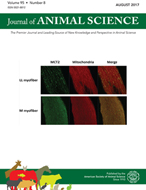-
Views
-
Cite
Cite
T. Serenius, K. J. Stalder, R. L. Fernando, Genetic associations of sow longevity with age at first farrowing, number of piglets weaned, and wean to insemination interval in the Finnish Landrace swine population, Journal of Animal Science, Volume 86, Issue 12, December 2008, Pages 3324–3329, https://doi.org/10.2527/jas.2007-0484
Close - Share Icon Share
Abstract
The objective of the study was to estimate genetic parameters for length of productive life (LPL), and determine its genetic correlation with age at first farrowing (AFF), number of piglets weaned at first farrowing (NW), and first wean-to-insemination interval (W2I) in the Finnish Landrace swine population. Data from the Finnish national litter recording scheme were utilized to estimate the genetics of LPL, and genetic associations between LPL, AFF, NW, and W2I. Data from the Finnish Landrace sow records were utilized from farms that farrowed more than 20 gilts annually from 2000 through 2005. The data set included information from 11,222 sows, all of which had AFF and NW information available. The sows producing the records evaluated were daughters of 1,267 sires, and there were 3,684 animals in the pedigree when all of the sires were traced back to founder animals. All data were obtained from FABA Breeding (Vantaa, Finland). Multivariate Bayesian analysis of Gaussian, right censored Gaussian, and categorical traits was utilized to estimate (co)variance parameters of LPL, AFF, NW, and W2I of the sow. From these traits, AFF and NW were treated as Gaussian, LPL as right-censored Gaussian, and W2I as categorical traits. Estimated posterior means of heritabilities were 0.22, 0.16, 0.09, and 0.08 for LPL, AFF, NW, and W2I, respectively. A relatively large proportion of variance due to farm-year interaction was observed (posterior means of f2 ranged between 0.03 and 0.26). The LPL was moderately genetically correlated with NW and AFF (posterior means were −0.20 and 0.36, respectively), whereas no clear association was found between W2I and LPL. Favorable genetic correlations between AFF and W2I and between NW and W2I were also observed. Additionally, an unfavorable genetic correlation between AFF and NW was observed in the present data set. Because LPL is genetically associated with other economically important prolificacy traits, it should be included in a multiple trait swine breeding value estimation system.





